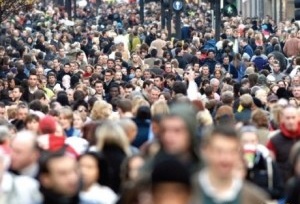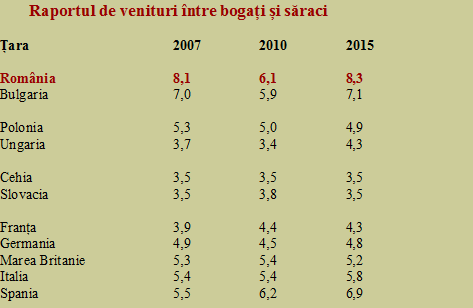 Somewhat paradoxically, the unequal distribution of income in Romania decreased during the crisis and returned in 2015 to a higher level than at the time of joining the European Union. In other words, the benefits of resuming the economic growth and recovering the GDP above the 2008 level have been mostly awarded to a small segment of the population, which largely explains the growing social tensions.
Somewhat paradoxically, the unequal distribution of income in Romania decreased during the crisis and returned in 2015 to a higher level than at the time of joining the European Union. In other words, the benefits of resuming the economic growth and recovering the GDP above the 2008 level have been mostly awarded to a small segment of the population, which largely explains the growing social tensions.
The ratio between the share of total incomes that goes to the 20% of the population with the highest incomes and the share of total revenue going to the 20% of the population with the lowest incomes (it should be understood as equivalised disposable income) was 8.1 in the first year of EU membership. Simply put, the richest Romanians gained about eight times more than the poorest fellow Romanians.
How relation between rich and poor developed
To note, 2007 was the first year when this indicator has been calculated based on the European methodology, to ensure comparability to other countries. The indicator fell to 6.1 in 2010, when the effects of the economic crisis were most intense, then it went increasingly faster back to higher levels. Consequently, it reached 8.3 in 2015, higher than in 2007 and the highest within the European Union.
*
- Year
- Income of rich/poor
*
If position ourselves within the European context, we can see that things are even worse than would seem at the first glance. Despite the devastating income ratio, clear cause of damage to social cohesion, Romania is NOT the country where the richest get most of the benefits, but the country where poorest get the least of the economic activity results.
Lithuania has a share of 44.4% allocated to the rich, compared to 42.3% in our case, a level that is anyway well above the EU average of 38.8%. At the other end, we are unfortunately the EU red flashlight, with a share of only 5.1% of incomes going to the poorest fifth of the population.
Average and extreme cases in the EU in terms of income inequality:
*
- The richest 20% Average EU28 Lithuania Slovenia
- The poorest 20% Average EU28 Romania the Czech Republic
- Source: Eurostat, Figures for the Future, 2016 edition
*
If we refer to the 57% standard of living in Romania compared to the EU average and compare the values above against the national average, we obtain a social configuration with one fifth of Romanians, with the highest income, is at 120% of the EU average and the other fifth lives at around 14.5% of that average.
How we are doing compared to other countries from the Union
The data are briefly presented below for some countries, according to the Eurostat reports for 2007, 2010 and 2015, with the idea to compare us with other countries having a similar level of development and the major Western democracies. It shows quite clearly that we are well off the European practice, be it central or Western. Besides, we are doing even worse in terms of income inequality than our slightly poorer neighbours from the South of Danube.
*
- Income rate between rich and poor
*
As a model to follow, as in other cases related to the economy, we would also take the Polish model. An example that developed independently of the crisis and steadily adjusted to Germany’s practice, which it almost reached last year. On the Latin branch, though, we are more like Spain or Italy (of course, on different levels of economic performance redistribution, despite our socialist past and their capitalist past), countries where inequality has deepened over the recent years.
As for the Czech-Slovak moderation and consistency, it is very unlikely for us to ever reach such ratio in terms of income between the richest and the neediest citizens. Incidentally, just a way of saying, from the Romanian perspective, by excluding Bucharest-Ilfov region, the other regions have people about as wealthy as the poorest 20% of the Czechs.
Paradox: Inequality decreased during the right-wing governments and grew during left-wing ones
Chances to Europeanize the redistribution of the economic results are minimal as neither from a political perspective is it seen any correlation with the ideology encouraged in theory. Here, over the ten years of EU membership (for a variety of reasons), inequality declined during the so-called right-wing governments and rose back exactly when left-wing declared governments ruled.
The problem is that before bringing the convergence of living standards to 60% or 75% of the EU average, we should do something to no longer have the devastating ratio between the richest and poorest at a level almost double compared to the European good practice. Including in terms of euro adoption, as we cannot join the Eurozone with such a South American like living standards gap between citizens.












